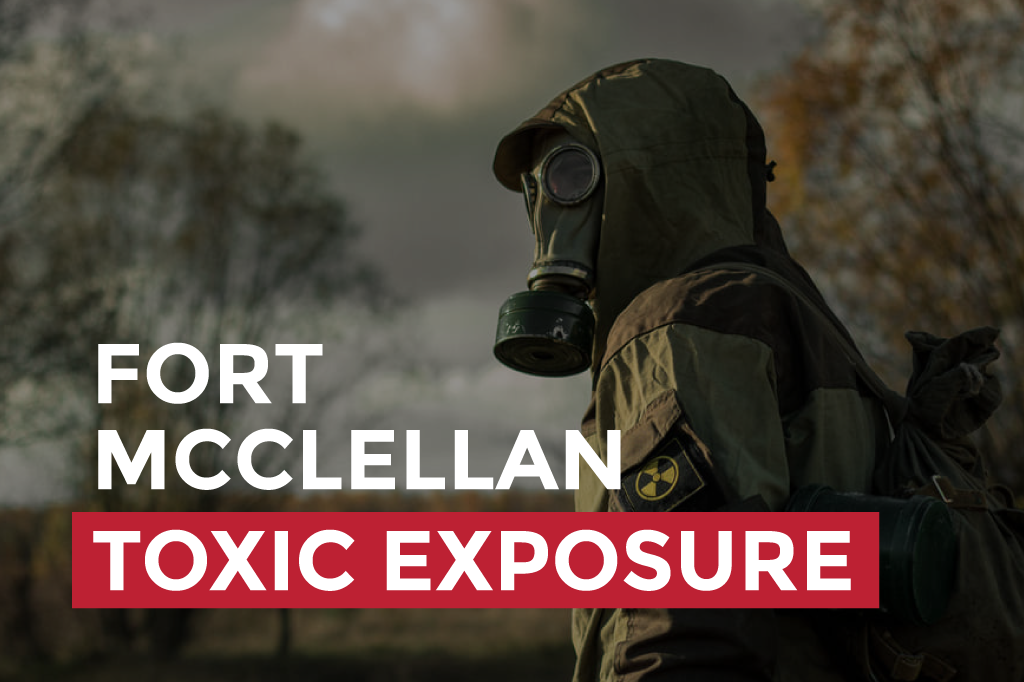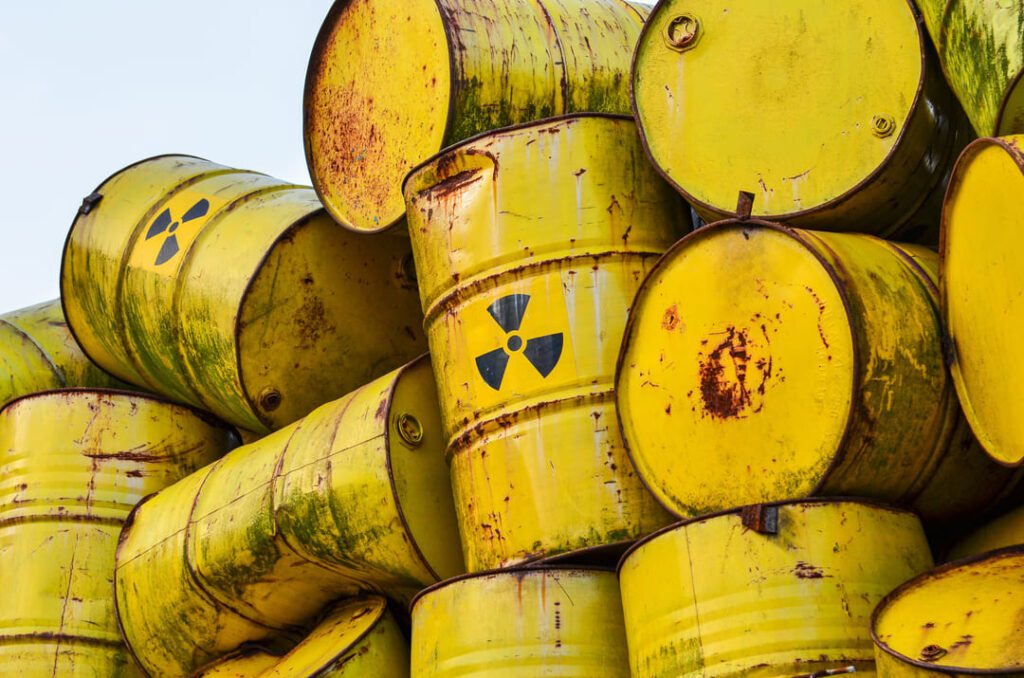Looking for Expert-Level VA Claim Answers?📱Call Us Now! 737-295-2226
Drone footage captured above Fort McClellan reveals the stunning natural beauty of the rolling hills surrounding the grounds of the former Army base near Anniston, Alabama. But there is more to Fort McClellan’s story than what meets the eye.

From 1917 and up until its closure in 1999, Fort McClellan has housed hundreds of thousands of military personnel. Many may have been exposed to various hazardous materials, including radioactive compounds, chemical warfare agents (including mustard gas and nerve agents), and polychlorinated biphenyls (PCBs).
- Did Fort McClellan Exposure Affect Your Health?
- Why Was Fort McClellan Closed?
- Is Fort McClellan Toxic?
- Could I Have Been Exposed to Toxins at Ft. McClellan?
- What Chemicals Were Stored at Fort McClellan?
- What Illnesses are Associated with These Toxins at Ft. McClellan?
- Should I File a VA claim for Chemical Exposure at Fort McClellan?
- Get Support with Your VA Claim—and Get the Compensation You Deserve.
- About the Author
Did Fort McClellan Exposure Affect Your Health?
Exposures to high levels of these compounds have been shown to cause adverse health effects (in both humans and lab animals). And although the VA states there is no evidence of exposure at levels needed to produce long-term health effects having occurred at Fort McClellan, it may still be worth your time to learn more about dangers associated with these toxins.
Deserve a Higher VA Rating?
Book a no-obligation VA Claim Discovery Call with an experienced team member. We’ll review your situation, spot what the VA may have missed, and help you map out a strategy to unlock the VA disability rating and tax-free compensation you’ve earned for your service. Click the red button below to book your call.
Why Was Fort McClellan Closed?
In 1999, Fort McClellan was closed as part of the Army Base Closure and Realignment Committee (BRAC) program. The BRAC program is part of a government effort to increase Department of Defense (DoD) efficiency by realigning or closing some U.S. military bases.
This process is run by a BRAC Commission consisting of a nine-member independent panel chosen by the President. The first BRAC closings were in 1988, and there have been BRAC rounds in 1991, 1993, 1995 and 2005, with over 350 installations closed.
BRAC legislation required the environmental cleanup of Fort McClellan before its transfer to the public domain. This cleanup is standard practice at all locations and ensures environmental compliance (under federal and state environmental laws and regulations).
The EPA commonly assists with cleanups, stating, “Because these facilities often encompass hundreds of acres with buildings, roads, and other infrastructure, their effective and efficient cleanup and reuse can play a pivotal role in communities’ economic development.”
Once cleanups are complete, redevelopment of the land can begin. The goal is to help local communities put these properties into economically beneficial use as soon as possible.
Is Fort McClellan Toxic?
Fort McClellan has a long history of chemical exposure. From as early as the 1920s, the installation served as a location for scientific research, as well as for Army and Alabama National Guard training.
Congress purchased the property in March 1917, just weeks before the U.S. declared war on Germany in The Great War (World War I). Fort McClellan (named Camp McClellan until 1929) was used as an Army training and mobilization center. Later, the base became a demobilization station and chemical warfare training ground.

The research conducted at Fort McClellan was on some of the most volatile compounds ever used by the military. In the years until Fort McClellan was closed in 1999, research was conducted using chemical, biological, and radioactive compounds such as Agent Orange, Napalm-B, and nerve agents.
Additionally, for the 42-year period ending in 1972, the nearby Monsanto chemical plant polluted the water and airways surrounding Anniston, AL, with toxic chemicals—including PCBs.
Could I Have Been Exposed to Toxins at Ft. McClellan?
Yes, it’s possible. Between 1927 and 1999, over 600,000 troops were likely exposed (either directly or indirectly) to a variety of toxins at Fort McClellan, including radioactive compounds (cesium-137 and cobalt-60), chemical warfare agents (mustard gas and nerve agents), and airborne polychlorinated biphenyls (PCBs).
Indirect exposure likely came through the air, soil, and water that the toxins polluted, while direct exposure was more likely if you participated in chemical weapons training.
The pollution came from both the military installation and the nearby Monsanto chemical plant. Monsanto settled a class-action lawsuit with the local community residents of Anniston and Pelham in 2003 (the veterans who lived and trained at the Fort were not included in that lawsuit).
The Fort McClellan toxins are connected to numerous health issues. The VA acknowledges potential Fort McClellan toxic exposure to some groups who have served at Fort McClellan, including:
- U.S. Army Chemical Corps School (Army Chemical School)
- The Women’s Army Corps serving at the Fort McClellan Army Base (WAC)
- Army Combat Development Command/Chemical/Biological/Radiological Agency
- Army Military Police School
For more information, see The VA website “Potential Exposure at Fort McClellan.”
.
What Chemicals Were Stored at Fort McClellan?
Beginning in the 1920’s Fort McClellan stored a variety of chemicals, including:
- Agent Orange
- Agent Blue
- Blister agents
- Cesium (Cs-137)
- Cobalt
- Napalm-B
- Nerve agents
- Plutonium
- Polychlorinated biphenyls (PCB)
- Sulfur mustard
- Uranium
- White phosphorus

These toxins were stored at Fort McClellan, and many were later destroyed in the incinerator. Over time, some of the toxins kept in containers ended up leaking into the soil, creeks, streams, and aquifers that fed the wells at Fort McClellan. This leak was regarded as a disaster by the National Wildlife Refuge nearby.
What Illnesses are Associated with These Toxins at Ft. McClellan?
Listed below are compounds and their associated health effects that the VA acknowledges are specific to Fort McClellan.
LIST OF DISEASES — FORT MCCLELLAN
Agent Orange:
Fort McClellan veterans do not receive presumptive Agent Orange exposure (even though an Army report conceded large-scale use of Agent Orange). Between 1974 and 1976, the Army dumped nearly 30,000 gallons of Agent Orange at the base. Agent Orange exposure is linked to:
- Amyloidosis
- Diabetes Type II
- Hodgkin’s disease
- Leukemia
- Lymphomas
- Myelomas
- Parkinson’s disease
- Peripheral Neuropathy
- Prostate Cancer
- Respiratory cancers
Agent Blue:
- Bladder cancer
- Leukemia
- Liver cancer
- Lung cancers
- Lymphatic cancers
- Skin cancers
- Stomach cancer
Cesium (Cs):
Large amounts of Cesium can cause cell damage.
Cobalt (Co-60):
High levels of Cobalt exposure can cause cell mutations (and may cause the development of some types of cancers).
Nerve Gas Agents:
- Abdominal cramps
- Blurred vision
- Chest tightness
- Diarrhea
- Excessive salivation
- Paralysis
- Tremors
Plutonium:
Can cause bone cancer, liver cancer, lung cancer, and immune system impairment.
- Polychlorinated Biphenyls (PCBs):
- Anemia
- Changes in the immune system, behavioral alterations, and impaired reproduction
- Liver cancer
- Liver damage
- Skin conditions
- Thyroid gland injuries
Sulfur Mustard:
- Bronchitis
- Long-term respiratory problems
- Lowered sperm count
- Respiratory cancers
Uranium:
Kidney damage, if ingested, increases the probability of cancer.
Should I File a VA claim for Chemical Exposure at Fort McClellan?
Claims related to toxic exposure at Fort McClellan are not the easiest to win, but it can be done. Much is still unknown about the long-term health impacts of many of the chemicals used at Fort Mcclellan, but an independent medical opinion can help link disability conditions to exposures at the base.
If you believe you have a disability condition related to exposure from your time at Fort McClellan, it’s vital that you obtain a professional medical opinion.
The independent medical opinion should include medical evidence as well as scientific data linking your disability condition to your exposure. The evidence only needs to show that it’s at least as likely as not that your disability condition is connected to your exposure.
Get Support with Your VA Claim—and Get the Compensation You Deserve.
Regardless of whether you spent time at Fort McClellan, it’s important to pursue monthly compensation and benefits for any disabilities connected to your military service.
Most veterans are underrated for their disabilities and therefore not getting the compensation they’re due. At VA Claims Insider, we help you understand and take control of the claims process, so you can get the rating and compensation you’re owed by law.
Our process takes the guesswork out of filing a VA disability claim and supports you every step of the way in building a fully-developed claim (FDC).
If you’ve filed your VA disability claim and have been denied or have received a low rating—or you’re unsure how to get started—reach out to us! Take advantage of a VA Claim Discovery Call. Learn what you’ve been missing—so you can FINALLY get the disability rating and compensation you deserve!
We’ve supported more than 25,000 veterans to win their claims and increase their ratings. NOW IT’S YOUR TURN.
About the Author

Brian Reese
Brian Reese is a world-renowned VA disability benefits expert and the #1 bestselling author of VA Claim Secrets and You Deserve It. Motivated by his own frustration with the VA claim process, Brian founded VA Claims Insider to help disabled veterans secure their VA disability compensation faster, regardless of their past struggles with the VA. Since 2013, he has positively impacted the lives of over 10 million military, veterans, and their families.
A former active-duty Air Force officer, Brian has extensive experience leading diverse teams in challenging international environments, including a combat tour in Afghanistan in 2011 supporting Operation ENDURING FREEDOM.
Brian is a Distinguished Graduate of Management from the United States Air Force Academy and earned his MBA from Oklahoma State University’s Spears School of Business, where he was a National Honor Scholar, ranking in the top 1% of his class.


